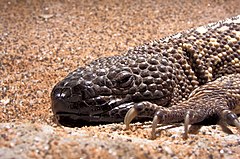Mexican beaded lizard
| Beaded lizard | |
|---|---|
 |
|
| Scientific classification | |
| Kingdom: | Animalia |
| Phylum: | Chordata |
| Class: | Reptilia |
| Order: | Squamata |
| Family: | Helodermatidae |
| Genus: | Heloderma |
| Species: | H. horridum |
| Binomial name | |
|
Heloderma horridum (Wiegmann, 1829) |
|
| Synonyms | |
|
Trachyderma horridum Wiegmann, 1829 |
|
Trachyderma horridum Wiegmann, 1829
The Mexican beaded lizard (Heloderma horridum) is the most famous of the four species of venomous beaded lizards found principally in Mexico and southern Guatemala. It and its congener the Gila monster (Heloderma suspectum) are the only lizards known to have evolved an overt venom delivery system. The beaded lizard is larger than the Gila monster, but has duller coloration, black with yellowish bands of differing width depending on the species. As it is a specialized predator that feeds primarily upon eggs, the primary use of its venom is still a source of debate among scientists. However, this venom has been found to contain several enzymes useful for manufacturing drugs in the treatment of diabetes, and research on the pharmacological use of its venom is ongoing.
Threatened throughout its range by overcollection and habitat loss, it is a CITES protected species. The Guatemalan beaded lizard (H. charlesborgeti) is one of the rarest lizards in the world, with a wild population of fewer than 200.
The beaded lizard has one close living relative, the Gila monster (H. suspectum), as well as many extinct relatives in the Helodermatidae, whose genetic history may be traced back to the Cretaceous period. The genus Heloderma has existed since the Miocene, when H. texana ranged over most of North America. Because the helodermatids have remained relatively unchanged morphologically, they are occasionally regarded as living fossils. Although the beaded lizard appears closely related to the monitor lizards (varanids) of Africa, Asia, and Australia, the wide geographical separation and unique features not found in the varanids indicate the beaded lizard is better placed in a separate family.
...
Wikipedia

